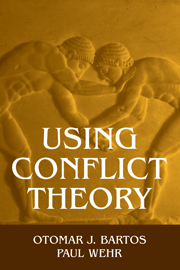Book contents
- Frontmatter
- Contents
- List of Figures and Tables
- Acknowledgments
- 1 Introduction
- 2 Understanding Conflict
- 3 Development of Incompatible Goals
- 4 Application to the Civil Rights Struggle
- 5 Emergence of Overt Conflicts
- 6 Application to a University Conflict
- 7 Escalation and Deescalation
- 8 Application to Conflict in Bosnia
- 9 Making Conflict Work Economically
- 10 Understanding and Managing Conflicts
- Appendix: Prelude to the Dissolution of Yugoslavia
- Notes
- References
- Index
Appendix: Prelude to the Dissolution of Yugoslavia
Published online by Cambridge University Press: 05 June 2012
- Frontmatter
- Contents
- List of Figures and Tables
- Acknowledgments
- 1 Introduction
- 2 Understanding Conflict
- 3 Development of Incompatible Goals
- 4 Application to the Civil Rights Struggle
- 5 Emergence of Overt Conflicts
- 6 Application to a University Conflict
- 7 Escalation and Deescalation
- 8 Application to Conflict in Bosnia
- 9 Making Conflict Work Economically
- 10 Understanding and Managing Conflicts
- Appendix: Prelude to the Dissolution of Yugoslavia
- Notes
- References
- Index
Summary
the progressive disintegration of Yugoslavia from 1991 onward can be seen as one part of the larger process of political reorganization in Soviet bloc nations, begun by the Polish Solidarity movement in 1980 (Wehr 1985). The winds of change were blowing into every corner of central and eastern Europe. But Yugoslavia, as a Communist state long independent of the Soviet Union, had an unusual set of factors variously restraining and stimulating conflict among its republics and ethnic communities.
The Early Stage
Yugoslavia had become a nation-state – a constitutional monarchy – only at the end of World War I. Until then, the region had been an uneasy frontier among the Austro-Hungarian, Russian, and Ottoman empires. Each empire had used its coreligionists in the area – Croatian Catholics, Serbian Orthodox, and Muslims – to further its imperial aims. In fact, the assassination of Austro-Hungarian archduke Ferdinand in 1914 by a Serbian nationalist in Sarajevo provided the flashpoint for World War I.
Between the world wars, Yugoslavia's fragile nationhood was held hostage by nascent Croatian and Serbian nationalism. But Yugoslav communism and the political nationalism forming around Tito during World War II provided an integrating force countering any tendencies toward ethnic separation. Tito, a Moscow-trained operative whose real name was Josip Broz, emerged as the leader of antifascist forces and became a legendary hero – the first real embodiment of Yugoslav nationalism. With massive popular support, his Yugoslav Communist Party easily assumed control of postwar Yugoslavia.
Information
- Type
- Chapter
- Information
- Using Conflict Theory , pp. 188 - 195Publisher: Cambridge University PressPrint publication year: 2002
